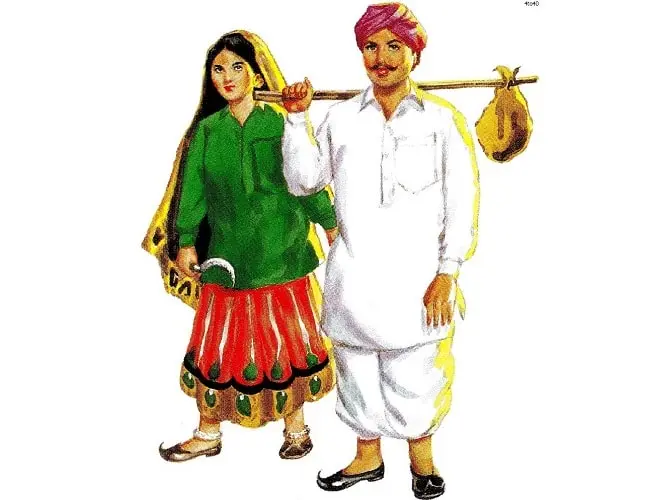Haryana stands as one of the richest states in India and one of the most prosperous regions in all of South Asia. The inhabitants of Haryana, however, are known for being unpretentious and easygoing. The vast majority of Haryanvis work in agriculture and practice vegetarianism. They live fairly ordinary lives.
You could say the same thing about their clothes. Their clothes are simple and functional. Dhoti kurtas are worn by males, whereas kurta lehenga are worn by ladies.
Communities have their own distinct styles when it comes to clothing. Women of diverse castes wore bright, vibrant colors, in contrast to the traditional white that males wore.

Here is a list of traditional dress that men and women of Haryana wore:
Traditional dress of men
Light blankets
The people of Haryana prefer to wear shawls && stoles in a desi manner. During the colder months, you can see a lot of people with a blanket wrapped around their middle.
They are not similar to bed blankets, but a more manageable kind of those! Although lightweight, it provides the same level of warmth and comfort as heavier coats. They’re so toasty that some people even wear them while riding motorcycles for short distances.
Long sleeve shirts
The Jatt Community, which constitutes the vast majority of Haryana’s population, is known for its innovative takes on traditional dress. Not just males, but also women, frequently don long-sleeved tops in this region.
Women typically dress in shirts or kurtas. The two most noticeable ones are these. The majority of these garments is constructed of one hundred percent cotton and feature understated but stylish embroidery.
Pagri
The Pagri is a type of headwear common in several countries, including Haryana. The males of Haryana traditionally wore this basic turban, although these days it is more common to see persons of advanced age donning one.
The young males enjoy concealing their ears with mufflers. That is both trendy and practical because it keeps their head warm.
Dhoti
The fact that the dhoti is also traditional clothing in Haryana lends it the air of a priceless relic. Men around the state can be seen sporting this style. It is also typically worn with a kurta and some form of head covering, most commonly a turban.
There have been several shifts in how this dress is worn over time. And if you take a look at them, you’ll see that the market offers a wide range of options.
Traditional dress for Women
Ghaghra
Haryana is a major wearer of ghagra. Women in the rural or remote areas of Haryana are likely to wear this with a blouse and scarf. The Ghagra, the traditional skirt worn by women in Rajasthan, can be as short as the ankles or as long as the floor, depending on the style.
Damaan, another name for Ghagra, refers to the garment’s numerous vibrant hues. This type of clothing is known for its elaborate borders, patterns, prints, & a wide variety of designs.
Odhni and Angia
The name and pronunciation of this blouse vary from region to region. Angia is the common name for it in Haryana. It’s worn with a wide variety of outfits and serves as a component in others. Women typically pair it with Ghagra since the two pieces look great together. In addition, Angia is a form-hugging variation of the blouse.
Among the many groups that call Haryana home is the Ahir people. This outfit including a lehenga is typical of their clothing. The complementary item is called “chunder.” Odhni is just their name for a dupatta. These are as well-liked as the regional wear of Haryana, and they’re made of cotton.
Accessories
The first item of jewelry is a neckpiece called a kathla, and it is typically worn by women of the Jatt caste. This jewelry is reserved for special events, although it may be worn anywhere.
Malas, are also a type of Bania jewelry typically worn by women. It’s a lengthy necklace with a wide variety of studs and pendants to choose from. Some of the pendants are quite sizable and it’s made of gold. This is another high-priced item that women only break out for major life events like weddings and festivals.
The Hansil is another piece of jewelry that is traditionally worn by women in Haryana. However, there is one key difference. This is a style popular among women of a certain age.
Conclusion
Traveling men, in particular, have been influenced by Western culture and begun donning trousers and shirts. Except in the largest cities, fewer women are seen wearing pants & tops typical of the West. The winter months of January and December also see the people of Haryana donning sweaters.
The traditional wedding attire of Haryana is well-known around the world. At these weddings, lehengas are a popular choice for the women. Haryanvis dress simply because they live a straightforward lifestyle.

